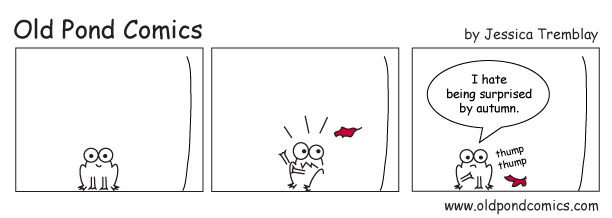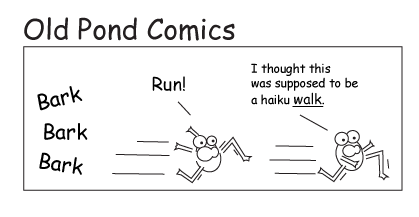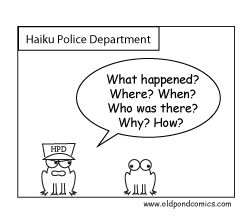Haiku: a short introduction (with cartoons)
What is a haiku?
A haiku is a short poem from Japan that describes, in only three lines, "what is happening in this place at this time" (Basho). It contains a word related to the season, and uses two images to give the reader a sense of wonder or aha! moment.
Should I count syllables?
Most traditional Japanese haiku were written in 17 on (sound units), but when you write haiku in English you don't have to count syllables.
Instead, try to write your haiku following a "short-long-short" pattern (meaning: the first line is short, the second line is longer, and the third line is short.) Example:
toy store
a client returns
a boomerang
- Jessica Tremblay

Short
Haiku is often called "one breath poetry" because the whole poem is so short that it can be said in one breath.
Brevity is an essential element of haiku. Avoid unnecessary words (adjectives, adverbs). Make every word count. Some people say ten words are often enough to write a haiku.
Be specific. "A flower" is nice, but if you write "A red tulip", people will see the image better.

Two images
A good haiku features two images. In English, sometimes the pause between the two images is marked by a dash or an ellipsis . . . But most of the time, the pause is a natural pause at the end of the line and you don’t need to add any punctuation.
When choosing your two images, the two techniques more frequently used are: comparison, contrast, association.
The juxtaposition of two images is key to creating an element of surprisem the aha! moment that triggers emotions in the reader. A good haiku helps us see the world in a different view.

Season word (kigo)
Most haiku will contain a word indicating the season. This "season word" is called a kigo.
This doesn't mean you have to name the season as in "autumn evening" or "summer rain". Certain words naturally refer to a particular season.
For example, the word "pumpkin" implies the haiku is taking place in autumn, "cherry blossoms" means it's spring.
Don't use more than one kigo per haiku. One is enough.

Go for a haiku walk
Haiku poets always carry a small notebook in their pocket when they go on a ginko (a walk done in search of inspiration to write a haiku).
During a ginko walk, observe what is happening around you. Use all your senses. Write down everything that you see, hear, touch, taste, smell. Anything that catches your attention.
Sometimes, a haiku will come to you already finished, in three lines, with two images. Sometimes, you’ll have a list of images, but no haiku yet. When you re-read these notes after your walk, maybe you’ll find a second image that will complete the haiku.

Let’s write a haiku
1. Go on a walk and write everything you see.
2. When you come home, draw three lines on a piece of paper: a short line, a longer line, and another short line.
3. On the first line, write “I saw”.
(1) I saw ________________
(2) ___________________________________________________________
(3) ________________________________
4. On the next two lines, write down one thing you saw on your walk.
5. Now, erase the first line and replace it by another image. (Try using the techniques of comparison, contrast, or association, so your two images create a aha! moment.) If you're stuck, simply write where and when the poem is taking place. Example: "afternoon walk".
6. Your haiku is done!

Take the plunge
Take a walk to the park. Observe the nature around you. What is happening now? Is there a dog running in the park? What color is he? What is he doing? Is he barking? Why? What do you see, feel, taste, hear, feel? Write it down.
Remember: A haiku is a short poem that describes, in only three lines, what's happening in this place at this time (Basho).
Six basic rules of haiku
1. Keep it short
2. Write in the present tense
3. Follow a "short-long-short" pattern
4. Use your senses
5. Juxtapose two images
6. Include a season word
Learn Haiku through cartoons
www.oldpondcomics.com
Download
Print a free handout for your class:
Haiku: A short introduction (with cartoons) (pdf, double-sided)
Next Chapter: Reading Haiku>

